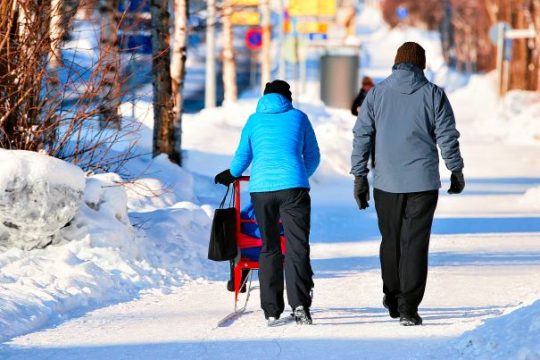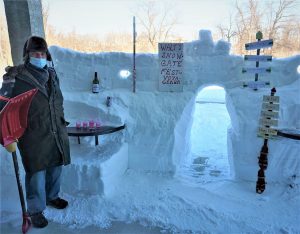
Winter is a beautiful season to get outside and enjoy the fresh crisp air. It can also be a precarious time of year for older adults.
With every surface sheathed in ice or snow, winter comes with the heightened risk of falling. For adults 65 years or older in Canada, falling is the leading cause of injury-related hospitalizations. These challenges multiply when limited mobility enters the equation.
While you might be tempted to hibernate during the winter months, seasonal affective disorder (SAD) and vitamin D deficiency can have negative effects on seniors’ physical and mental health. This means that addressing winter mobility challenges is a priority for caregivers. Read our tips to help seniors stay healthy and active this winter while using a gait aid.
Moving Safely Using a Cane or Walker
One way to reduce the risk of falls and increase independence is to use mobility or gait aids such as canes, walkers, or rollators. For the 1.9 million Canadians with mobility limitations, these provide additional stability and support.
Paradoxically, canes and walkers are also linked to an increase in falls-risk. The reason? Not using their gait aid at the time of falling, despite knowing that they help prevent falls. Some explanations that older adults give for not using prescribed walkers, canes, or other gait aids are:
- believing it was not needed
- forgetfulness
- the device makes people feel old
If you are unsure of how to use your mobility device most effectively, ask for help. Also, make sure that the device is adjusted to your specific needs. Never use another person’s gait aid.
How Can I Reduce the Risk of Falls While Using a Gait Aid?
 Snow and ice reduce underfoot traction, which makes it difficult for all pedestrians—particularly seniors—to make effective recoveries and prevent injury if they do slip. If you’re using a walker, rollator, or cane, getting around in the winter requires a little bit of extra precaution.
Snow and ice reduce underfoot traction, which makes it difficult for all pedestrians—particularly seniors—to make effective recoveries and prevent injury if they do slip. If you’re using a walker, rollator, or cane, getting around in the winter requires a little bit of extra precaution.
Wear Appropriate Winter Footwear
A simple safety measure to help avoid falling is to wear footwear with traction, even if you’re walking a short distance. Adding anti-slip shoe traction apparatus or ice cleats to your boots can further help to minimize the risk of slips and falls.
Beware of Ice
No matter how well the snow is removed from parking lots or sidewalks, there will still be slippery places. It’s important to remember that melting snow can freeze overnight, forming a thin layer of ice that is hard to see. The ground can then become very slippery in the morning when the ice starts to melt.
Ice and snow also can cause walking aids to slide forward farther and faster than they should, so extra precaution is needed.
Add Ice Grips to Cane Tips
Cane users should add an ice-grip tip with prongs to grip the ground and provide extra stability on slippery surfaces. However, you will still need to use extreme caution if walking on ice.
Remember to flip the ice pick down if it’s icy out and flip the ice pick up when you’re indoors.
Wash the cane’s rubber tips as soon as possible after coming indoors – the winter salt can cause the rubber to deteriorate faster. Regularly inspect the rubber tip at the bottom of your cane. This rubber tread is designed to provide traction in slippery conditions but wears out over time.
For Greater Stability, Change Your Walking Style
Use a slower and wider gait to better protect against falls. Learn how to Walk Like a Penguin — walk slowly, take small steps, and point your toes out slightly to be more stable on icy paths.
- Concentrate on keeping your balance
- Watch where you are stepping and go slowly
- Keep your head up and don’t lean forward.
Use a Safety Mobility Light
It gets dark earlier in winter, so you need to make sure you can see and be seen. Buy clip-on flashlights to affix to a walker or rollator to help you see more clearly.
Bring a Cellphone
If you should fall, you will be glad you brought your phone along to call a neighbor, loved one, or emergency medical help.
All Seniors Care Helps You Prevent Falls and Maintain Independence

Falls can be frightening, especially when you’re home alone. At All Seniors Care, where we place a high value on health, happiness, and overall wellbeing, seniors are never truly alone.
Our retirement communities in Canada support healthy seniors and those requiring assistance. Our client-centred approach ensures that older adults needing extra support are identified early. For example, ensuring eye and dental visits are up to date, putting strategies in place to reduce the risk of falls in suites (having the right assistive devices and footwear), making sure medication is taken as prescribed, and monitoring of weight, nutrition, and hydration.
November is Falls Prevention Month. Find out more by reading our 7 simple tips to help keep you on your feet.
Whether you’re interested in a retirement residence in Alberta, Manitoba, Ontario, Saskatchewan or Quebec, give us a call at your convenience and we’ll be happy to chat about how we are helping to significantly lower your loved one’s risk of falling.
